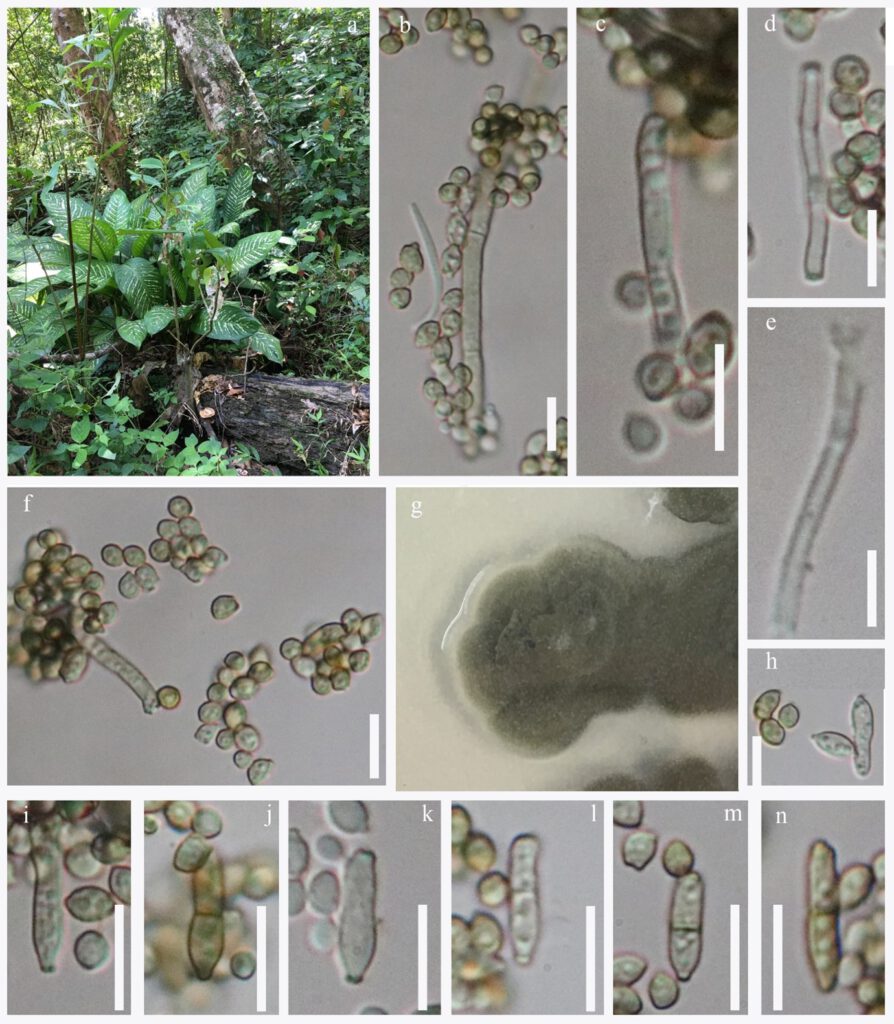Cladosporium halotolerans Zalar, de Hoog & Gunde-Cim., in Zalar, de Hoog, Schroers, Crous, Groenewald & Gunde-Cimerman, Stud. Mycol. 58: 172 (2007) (TNC6) (Fai)
MycoBank number: MB 492439; Index Fungorum number: IF 492439; Facesoffungi number: FoF 10751;
Holotype: Namibia, isolated from hypersaline water of salterns, 1 Sep. 2000, N. Gunde-Cimerman, isolated by P. Zalar, 1 Oct. 2000 (CBS H-19734). Ex-type culture: EXF-572 = CBS 119416. Lit.: Haubold et al. (1998a), Buzina et al. (2003), Meklin et al. (2004). Ill.: Zalar et al. (2007: 172).
Saprobic on Dracaena sp. Sexual morph: Undetermined. Asexual morph: Mycelium 2–4 μm wide (x̅ = 3.2 μm; n = 30), partly superficial partly submerged; hyphae branched, septate, often appearing somewhat darkened and not constrictions, irregular, hyaline to pale brown or pale olivaceous-brown, smooth, minutely verruculose, walls unthickened. Conidiophores 50–80 μm long × 2–3 μm diam. (x̅ = 65 × 2.5 μm; n = 30), micronematous to semimacronematous, arising laterally or terminally from hyphae, erect, straight to slightly flexuous, filiform to narrowly cylindrical 0–3-septate, septa often appearing darkened, sometimes pluriseptate with septa in short succession, especially towards the apex, septa not constricted, pale olivaceous-brown, smooth to minutely verruculose, walls unthickened or almost so, sometimes forming ramoconidia and fragments., unbranched or branched, brown occasionally slightly geniculate, non-nodulose. Conidiogenous cells undifferentiated or conidiophores reduced to conidiogenous cells, cylindrical, 4–18 μm long, usually neither geniculate nor nodulose, with a single or up to three protuberant, subdenticulate, thickened and darkened. Condiogenous scars thickened and conspicuous, protuberant. Ramoconidia rarely formed. Ramoconidia 6–12 × 2–3 μm (x̅= 8.5 × 2.5 μm; n = 30), a branch of a conidiophore at the base of branches having scar, having a truncate or slightly convex, to detached conidiogenous cells or short, fertile, terminal branches, and reclassified branched conidia. Conidia 5–6 × 2.5–2.6 μm (x̅= 5.5 × 2.5 μm; n = 30), catenate, in branched chains, conidial chains branching in all directions, terminal chains with up to nine conidia, small terminal conidia globose or subglobose, hyaline to dark brown, narrower at both ends, straight, guttulate.
Culture characteristics – Colonies on PDA reaching 20–40 mm diam after 2 weeks, olivaceous, grey olivaceous or olivaceous-grey, reverse olivaceous-grey to leaden-grey or olivaceous-black, velvety, powdery to felty-wooly, margins white, regular, glabrous or feathery, aerial mycelium absent or sparse, growth flat with a somewhat elevated colony centre, without prominent exudates, sporulation profuse.
Material examined – THAILAND, Songkhla Province, Hat Yai District, dead leaves of Dracaena sp. (Asparagaceae), 5 September 2018, Napalai Chaiwan, TNC6, ex-type living culture MFLUCC 18–0915.
Host – Saprobic, isolated from hypersaline water in subtropical climates, indoor environments, Arctic ice and biomass, contaminant in lesions of humans and animals, plants, rock, conifer wood and window frame, from mycorrhizal roots; probably circumglobal, Dracaena sp.—(This study).
Distribution – Africa (Namibia, South Africa), Arctics, Asia (India, Israel, Turkey), Australasia (New Zealand), Europe (Belgium, Bosnia and Herzegovina, Denmark, Germany, Italy, Russia, Slovenia, Spain, Sweden, Switzerland, UK), North America (USA) and Central and South America (Brazil, Dominican Republic), Thailand—(This study).
GenBank accession numbers – ITS: OM908928, TEF: ***, ACT: ***
Notes – In the phylogenetic analysis, our isolate grouped with Cladosporium halotolerans with high support (100 % MLBS/1.0 BYPP, Fig.***). A comparison of the phylogenetic tree indicates that our strain is Cladosporium halotolerans. Cladosporium halotolerans report by Zalar et al. (2007), this species report in osmotic ecological niches. The distribution recorded of this species collection from various habitats and as a culture contaminant in different parts of the world (Zalar et al. 2007). However, in our study we isolated the same species from Dracaena sp.

Figure ***– Cladosporium halotolerans (ex-type living culture MFLUCC 18–0915). a Habitat. b–e Conidiophore. f, h Conidia. i–n Ramoconidia. g. culture from PDA. Scale bars: b–f , i–n=10 μm. h=5 μm.
